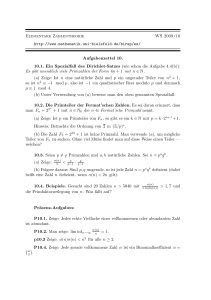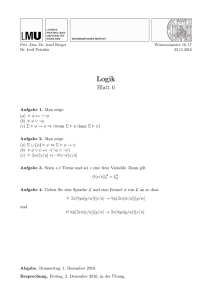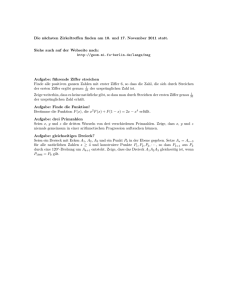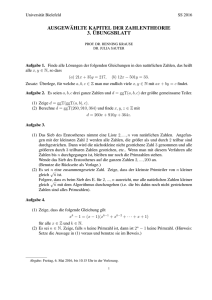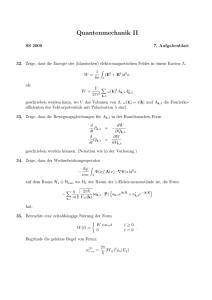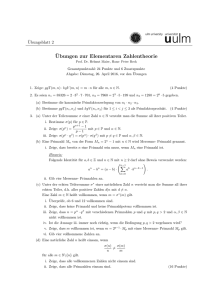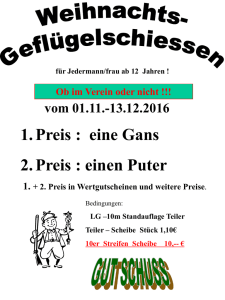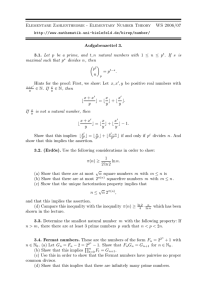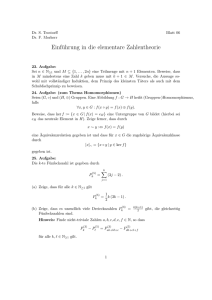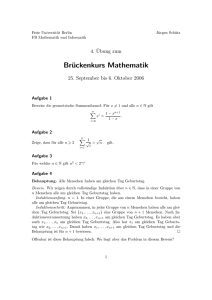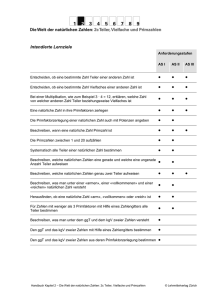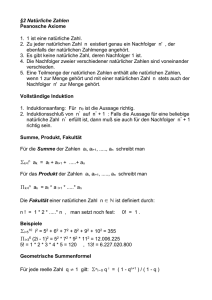pdf-File
Werbung
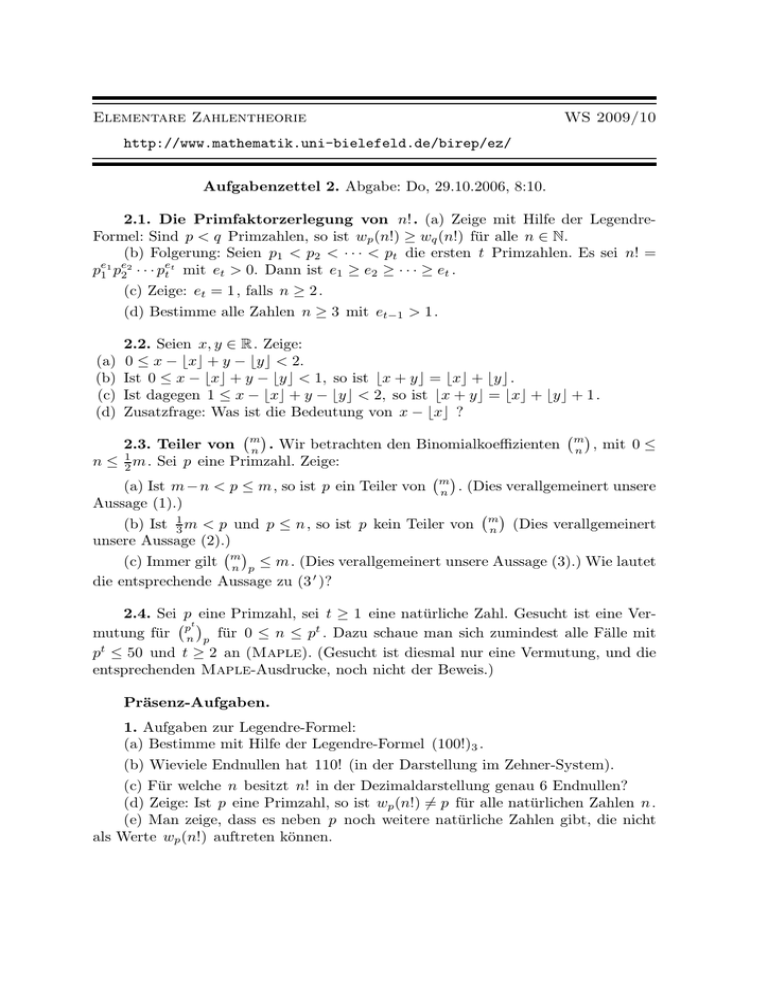
Elementare Zahlentheorie WS 2009/10 http://www.mathematik.uni-bielefeld.de/birep/ez/ Aufgabenzettel 2. Abgabe: Do, 29.10.2006, 8:10. 2.1. Die Primfaktorzerlegung von n! . (a) Zeige mit Hilfe der LegendreFormel: Sind p < q Primzahlen, so ist wp (n!) ≥ wq (n!) für alle n ∈ N. (b) Folgerung: Seien p1 < p2 < · · · < pt die ersten t Primzahlen. Es sei n! = e1 e2 p1 p2 · · · pet t mit et > 0. Dann ist e1 ≥ e2 ≥ · · · ≥ et . (c) Zeige: et = 1 , falls n ≥ 2 . (d) Bestimme alle Zahlen n ≥ 3 mit et−1 > 1 . 2.2. Seien x, y ∈ R . Zeige: (a) 0 ≤ x − ⌊x⌋ + y − ⌊y⌋ < 2. (b) Ist 0 ≤ x − ⌊x⌋ + y − ⌊y⌋ < 1, so ist ⌊x + y⌋ = ⌊x⌋ + ⌊y⌋. (c) Ist dagegen 1 ≤ x − ⌊x⌋ + y − ⌊y⌋ < 2, so ist ⌊x + y⌋ = ⌊x⌋ + ⌊y⌋ + 1 . (d) Zusatzfrage: Was ist die Bedeutung von x − ⌊x⌋ ? m 2.3. Teiler von m . Wir betrachten den Binomialkoeffizienten n n , mit 0 ≤ n ≤ 12 m. Sei p eine Primzahl. Zeige: (a) Ist m − n < p ≤ m, so ist p ein Teiler von m . (Dies verallgemeinert unsere n Aussage (1).) (b) Ist 31 m < p und p ≤ n , so ist p kein Teiler von m n (Dies verallgemeinert unsere Aussage (2).) (c) Immer gilt m n p ≤ m. (Dies verallgemeinert unsere Aussage (3).) Wie lautet die entsprechende Aussage zu (3 ′ )? 2.4. Sei p eine Primzahl, sei t ≥ 1 eine natürliche Zahl. Gesucht ist eine Vert mutung für pn p für 0 ≤ n ≤ pt . Dazu schaue man sich zumindest alle Fälle mit pt ≤ 50 und t ≥ 2 an (Maple). (Gesucht ist diesmal nur eine Vermutung, und die entsprechenden Maple-Ausdrucke, noch nicht der Beweis.) Präsenz-Aufgaben. 1. Aufgaben zur Legendre-Formel: (a) Bestimme mit Hilfe der Legendre-Formel (100!)3 . (b) Wieviele Endnullen hat 110! (in der Darstellung im Zehner-System). (c) Für welche n besitzt n! in der Dezimaldarstellung genau 6 Endnullen? (d) Zeige: Ist p eine Primzahl, so ist wp (n!) 6= p für alle natürlichen Zahlen n . (e) Man zeige, dass es neben p noch weitere natürliche Zahlen gibt, die nicht als Werte wp (n!) auftreten können. 2. Welche der folgenden Primzahlen sind Teiler von 300 150 ? 127 131 137 139 149 151 157 163 167 173 179 Translation: 2.1. (a) Use the Legendre formula in order to show: If p < q are prime numbers, then wp (n!) ≥ wq (n!) for every natural number n. (b) Consequence: If p1 < p2 < · · · < pt are the first t primes and n! = pe11 pe22 · · · pet t with et > 0, then e1 ≥ e2 ≥ · · · ≥ et . (c) Show: et = 1 , if n ≥ 2 . (d) Find all numbers n ≥ 3 with et−1 > 1 . 2.2. Let x, y ∈ R . Show: (a) 0 ≤ x − ⌊x⌋ + y − ⌊y⌋ < 2. (b) If 0 ≤ x − ⌊x⌋ + y − ⌊y⌋ < 1, then ⌊x + y⌋ = ⌊x⌋ + ⌊y⌋. (c) If 1 ≤ x − ⌊x⌋ + y − ⌊y⌋ < 2, then ⌊x + y⌋ = ⌊x⌋ + ⌊y⌋ + 1 . (d) Additional question: What is the meaning of x − ⌊x⌋ ? 2.3. Consider the binomial coefficient m , with 0 ≤ n ≤ 12 m. Let p be a prime. n Show: (a) If m − n < p ≤ m, then p is a divisor of m . (This generalizes the assertion n (1).) (b) If 13 m < p und p ≤ n , then p is not a divisor of m n (This generalizes the assertion (2).) (c) Always, we have m ≤ m. (This generalizes the assertion (3).) Formulate n p and proof the assertion corresponding to (3 ′ )?) 2.4. Let p be a prime, let t ≥ 1 be anatural number. We are looking for a t conjecture concerning the value of pn p for 0 ≤ n ≤ pt . Consider at least all the cases with pt ≤ 50 and t ≥ 2 (say using Maple). (We ask only for the formulation of a conjecture as well as the corresponding Maple outprints, but not yet for a proof). Routine exercises. 1. Use of the Legendre formula: (a) Determine (100!)3 . (b) Determine the number of final zeros in the decimal presentation of 110! (c) Determine all numbers n such that the decimal presentation of n! has precisely 6 zeros at the end. (d) Show: if p is a prime, then wp (n!) 6= p for all natural numbers n . (e) Show that besides p also other numbers cannot occur as values wp (n!) . 2. Which of the following primes are divisors of 300 150 ? 127 131 137 139 149 151 157 163 167 173 179
